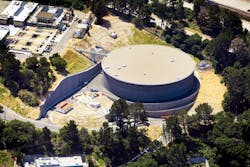Calvin Huey, P.E., is civil design section manager for San Francisco Public Utilities Commission. Huey can be reached at [email protected] or 415.554.3189. Kevin Peacock is senior regional manager for DN Tanks. Peacock can be reached at [email protected] or 949.698.2740.
undefinedThe Harry Tracy Water Treatment Plant (HTWTP), capable of supplying 180 mgd of water, is a critical component of the Hetch Hetchy Regional Water System that serves 2.6 million people in the San Francisco Bay Area. Recognizing the need for major upgrades to the aging water system, the San Francisco Public Utilities Commission and its 26 wholesale customers launched the $4.8 billion Water System Improvement Program (WSIP) to provide improvements necessary to meet level of service (LOS) goals established for seismic and delivery reliability, water quality and water supply. Under WSIP, one of the major goals of the HTWTP Long Term Improvements Project (LTIP) was to provide upgrades to the existing plant in the city of San Bruno that would limit damage and allow the plant to deliver a minimum of 140 mgd within 24 hours after a major earthquake on the San Andreas Fault, located less than 1,000 ft away.
Challenges & Seismic Considerations
Although the close proximity of the San Andreas Fault presented significant design challenges due to high seismic forces, the greatest project challenges were related to the presence of two previously unidentified traces of the lesser-known Serra Fault that cross the HTWTP property and are capable of movement in conjunction with an earthquake on the San Andreas Fault. The identification of the Serra Fault traces during geotechnical investigations resulted in retrofit of a 60-in.-diameter pipeline; installation of a new 72-in.-diameter pipeline crossing a fault trace and a new 78-in. diameter pipeline within the boundaries of fault traces; installation of seismic isolation valves to protect residential and school properties; and modifications to the design of new filters to avoid intersecting a fault trace. Most significant was the abandonment of two existing treated water reservoirs due to unacceptable ground deformations in the hillside below the foundations. These reservoirs were replaced with an 11-million-gal treated water reservoir (TWR) on the opposite side of the plant from the fault traces.
Tank Construction & Prestressing
The new TWR tank was designed as an AWWA D110 Type I prestressed concrete tank, constructed as such due to its proven seismic performance and extended service life. The tank floor, footings,
columns, walls and flat slab roof were all constructed with concrete. The corewall was constructed using cast-in-place concrete and was poured full height, which eliminated horizontal jointing. Designed with a wall height of 49 ft and a flat roof supported by 88 columns, the new reservoir was built to withstand earthquakes along the surrounding faults.
DN Tanks was the specialty prestressing subcontractor for the tank project. The corewall was prestressed in both the vertical and circumferential directions, which placed them in permanent compression, thereby utilizing the most efficient use of steel and concrete. Vertical prestressing incorporated specialized anchored flexible seismic connections at the wall base and wall top similar to a base isolation detail to maximize the ductility of the structure.
Circumferential prestressing for the tank involved application of 960 strand wraps totaling approximately 726,000 ln ft of prestressing strand (equivalent to 137 miles). The circumferential prestressing was applied by an automated mechanical force application system, which incorporated continuous electronic recording and monitoring to ensure accuracy. Upon completion of prestressing, the strand was encased and protected with shotcrete applied using the fully automated system.
Reliable Reservoir
Providing reliable water quality and delivery after a seismic event was a key goal in the WSIP upgrades. The new plant and prestressed concrete reservoir will be capable of supplying a minimum of 140 mgd of water within 24 hours of a major earthquake, thus providing a critical boost to public health and safety as the region recovers.
Download: Here


